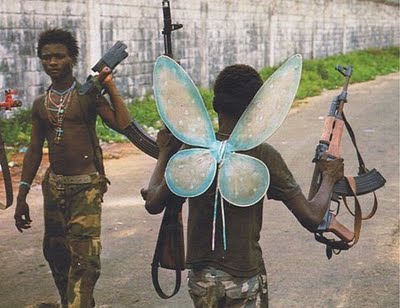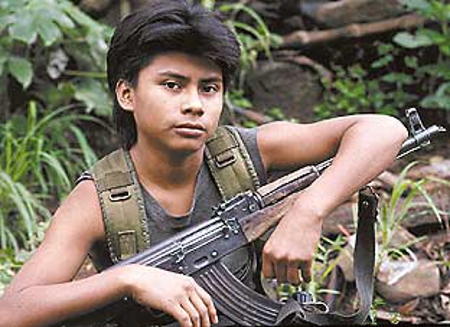Humanitarian rhetoric seems to have seeped into and reshaped the literary images of child soldiers, upending many of the images of children under arms that pervaded nineteenth- and twentieth-century literature. The transformation is startling: the heroic child fighters like Gavroche in Victor Hugo's Les Misérables or the boy spy Kim in Kipling's eponymous novel have been replaced by Ago, the battered victim of a nameless war in Uzodinma Iweala's Beasts of No Nation. This is not to suggest that there were no dissenting views in the past. As early as 1861, Herman Melville raised his skeptical voice against the chorus of hosannas surrounding young boys marching off to the Civil War. In his poem "The March into Virginia Ending in the First Manassas," he writes, "All wars are boyish, and are fought by boys, the champions and enthusiasts of the state." But Melville was in the minority, and it took more than one hundred years before his lone voice was joined by the noisy chorus of humanitarian critique.How did the heroic child soldier of an earlier era come to be replaced by the abused and exploited child who is both killer and victim? What alterations in literary conventions and moral attitudes were required in order to transform the child soldier into its modern literary construction? Clearly these changes are part of other major historic trends in thinking about war in general. Martin van Creveld has shown that before the eighteenth and nineteenth centuries, much of the commemoration of war in popular culture involved the celebration of victory over the enemy, often depicted as captured, defeated, or killed. But by the time of the U.S. Civil War and World War I, much of this had disappeared and the focus of popular culture became the commemoration of the dead, the heroic sacrifice and suffering. As shown earlier in this book, the commemoration of the death and sacrifice of child soldiers was particularly embedded in funerary rituals of communal and national grief. In that very important sense the death of the child soldier symbolized the death and sacrifice of all soldiers.
World War I provided an important opening to the reversal of these images in popular understanding of war. While the bulk of popular literature supported the war, there were important literary dissenters such as the British poets Siegfried Sassoon, Wilfred Owen, and Isaac Rosenberg. Owen's poem "Anthem for Doomed Youth" skewers the possibility that funerals for the young can have any meaning, asking, "what passing-bells for these who die as cattle?" Postwar novels and films broadened the critique. The 1929 novel All Quiet on the Western Front by Erich Maria Remarque details the physical and psychological cost of the war and became a best seller after the war.
The book tells the story of German schoolboys harassed and shamed into enlisting by their teacher and who are all killed in the war. In the book the boys are ages eighteen and nineteen, but in the 1930 Hollywood film of the same name, directed by Lewis Milestone, they appear to be somewhat younger high school boys. Nonetheless, these and numerous other films and books set forth an important, if nascent, critique of war and gave rise to the idea that warfare could also involve the cynical and meaningless sacrifice of the young. Much of the criticism focused on the tragedy of war and the corruption, hubris, and vanity of military and political leadership.
A classic example was Herbert Cobb's 1935 novel Paths of Glory (the source of the 1957 Stanley Kubrick film of the same name), focused on the true story of four French corporals randomly and cynically selected for execution as scapegoats for military folly and failure. But despite such portraits of immorality and borderline criminality by wartime commanders, war, per se, was not generally treated as a criminal enterprise. One possible exception was the 1927 Soviet film The End of St. Petersburg, directed by Vsevolod Pudovkin, in which the horrors of World War I are directly attributed to the criminal greed of capitalists. But the impact of these critical works was felt mostly in the post-World War I period and was soon set aside by the rise of Nazism in the 1930s.
Portraits of war as a criminal enterprise began to emerge more fully in contemporary literature and are especially prominent in literature that focuses on African conflicts. While children have been recruited as child soldiers in wars all over the world --- Colombia, Kurdistan, Laos, Mexico, New Guinea, Pakistan, Palestine, Peru, the Philippines, Sri Lanka, and New Guinea come immediately to mind --- the contemporary literary gaze remains firmly fixed on Africa. Exactly why is unclear. Certainly some contemporary examples of the use of child soldiers in Africa, such as the Revolutionary United Front in Sierra Leone and the Lord's Resistance Army in Uganda, have provided chilling examples of the abuse of children. But these extraordinary cases have also come to serve as the archetype of children's experiences in both Africa and elsewhere. Literary treatments of African children at war, almost all geared to Western audiences, magnify this perspective by the lingering tendency to see Africa with Conradian eyes, seeing only the heart of darkness. In fact the general Western discourse about war in Africa, whether precolonial, colonial, or postcolonial, has remained remarkably consistent since the middle of the nineteenth century, in this discourse, warfare in Africa --- in contrast to that in the West --- is invariably cast as irrational, meaningless, and criminal.
An extended review of this title
will appear in the next issue of RALPH
--- David M. Rosen
Child Soldiers in the Western Imagination:
From Patriots to Victims
©2015 Rutgers University Press

